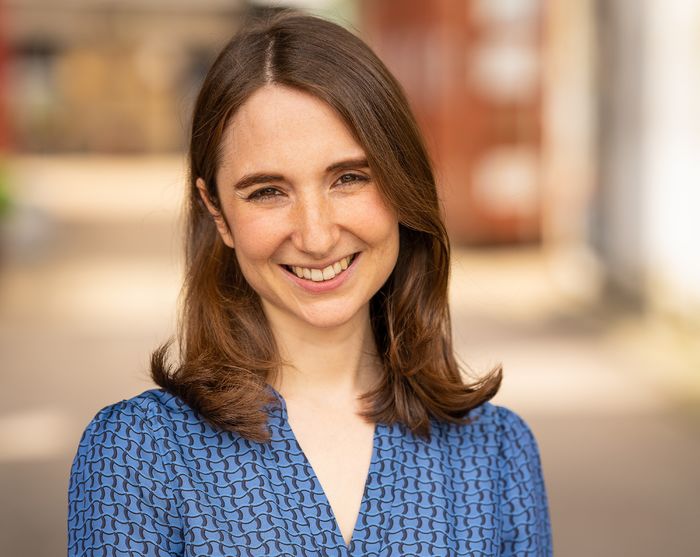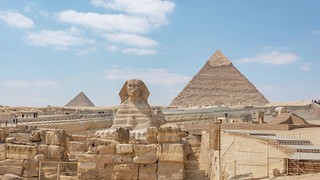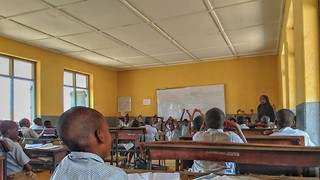In (between) the Emma Library
Ancient brick meets modern art in the Emma college library, as each piece sits in silent conversation with the space it inhabits. Madelaine Clark contemplates the timeless ‘betweenness’ of the gallery

Whenever I enter the Emmanuel College library, I feel unnervingly observed. The building, from the outside, is beautiful: at night the windows glow with fragments of stained glass, giving the impression of a teenager’s bedroom – warm, youthful, psychedelic, nocturnal – somewhere ‘in-between’ and out of time. Inside, however, traipsing up to the Fane Room, I feel a pair of eyes watching on intently. The stare of Jesus Christ bores into me.
“It gives the impression of a teenager’s bedroom – warm, youthful, psychedelic, nocturnal – somewhere ‘in-between’ and out of time”
It isn't because I haven’t finished my essay. John Constable’s altar painting, towering at the entrance of the library, depicts a few lines from Mark 10, where Christ blesses a child in his arms. The effect should be magical, miraculous, but it fails on me. All I see is the engorged head of the blessed baby, looking concerningly swollen and equally unimpressed – cleansed, but straining as though soiling its nappy. The other subjects in the painting have their eyes awkwardly averted; I, too, as I walk up those stairs, pretend I can’t see.
Constable was pressured into religious subject matter – really, he preferred landscapes. His parents, reluctant to allow such an unstable pursuit, agreed to his career in artistry so long as he concentrated on the "more dignified and remunerative painting of portraits and historical and religious subjects", as fellow Barry Windeatt writes in an accompaniment to the painting. The ballooning heads of his figures are perhaps symptomatic of these rising pressures, bulging as if in an autoclave, or perhaps they are merely the result of inexperience. Regardless, I find the subject humorous. It is perfect for the Emma library – grand but playful, hundreds of years old, with a rainbow of lightheartedness smirking across it.
We often think about spaces being altered by the paintings they keep, but I wonder, rather, how paintings are altered by their spaces. Poetry blends into architecture through its careful handling of structure, architecture passes into painting, and all art aspires to the evolutionary acme that is music. Everything hums when we get close to it.

Art is often protean. I think about this as I climb the levels of the library, pausing on each stairwell where a painting or print is framed. A few of the pieces here border on abstract – Victor Passmore’s untitled 1972 etching, for instance, shows a pockmarked page, burnt and grey, with scrawls and cracks across it like a broken window, or the frantic message of a stroke patient, striving to be understood. I look at it sideways, dramatising my own confusion. Perhaps because of where I am, it begins to look like an open book. Abstract art, however, is anything but transparent. The disorientating piece requires actual disorientation to be ‘read’ – it is framed chaos – and I am baffled, for a moment, why it would ever be put in a library. Panic settles there, buzzing and jerking behind a thin pane of glass.
“We often think about spaces being altered by the paintings they keep, but I wonder, rather, how paintings are altered by their spaces”
The top floor stairwell, too, is decorated with a piece by Sean McGuerney, and it is ugly, greasy, and impossible. Though the painting is titled ‘Country Field, Sligo’, friends in the past have called it a chicken, others a fist, and I personally see the lanes and bulbous houses of a suburban cul-de-sac, American and somewhere off-yellow. It cannot commit to its shape; it can barely commit to its colour. This kind of Rorschach art has never appealed to me, for, like an evasive word, it bears only a suggestion of something, and leaves it stuck awkwardly on the tip of my tongue.
Another stairwell bears a painting by Brian Bourke (b. 1936), titled ‘Autumn 1967, No 1’. It evokes what looks to be a storm at night, the branches clenching together to withstand the tempest, becoming indistinguishable in blackness. The next hangs a print of a midnight London intersection, by Richard Jacobs – more metropolitan than the last, but equally dark and drizzly.
I’ve become fond of these contained confusions. At first, they seemed incongruous with the silence of a college library, taunting its stressed-out students with even more unanswered questions. But now, when I look at these paintings, I find that they’ve borrowed some indescribable force from the building, capturing its scholastic hush and that feeling of timelessness – a silence so prominent, even the clocks stop ticking. Jacobs’ London tableau, for instance, evokes the beauty of street lamps in darkness. The scene is of an intersection beside Blackfriars Bridge – somewhere between places (between directions, even) – and a sign pronounces angrily: ‘NO WAITING’. But the form of a painting rebels against this. It is a moment caught in time, static, halting, and asking its viewer, too, for pause.
The ‘betweenness’ of the library space has been borrowed by these paintings like a book. Maurice Stubbs’ 1967 landscape, showing a cool, white expanse of what could be sand or snow, is empty and inviting. The scribbles of Passmore’s piece are equally inscrutable – somewhere between madness and expression – but they remind me that all penmarks are personal, and I find myself trying to translate its sprawling loops. I am even drawn, now, to the oily abstraction of McGuerney’s piece, capturing the serenity of non-apprehension within its yellow swabs.
After an evening spent in the Emma library, I leave with my brain feeling just as inflamed as the Christ figure bidding me goodbye. But whenever I return, I see all of its art melting together, and am drawn back into its strange refuge.
 Features / Cambridge SU: has-been or never-was?16 September 2025
Features / Cambridge SU: has-been or never-was?16 September 2025 Arts / A walking tour of Art Deco Cambridge16 September 2025
Arts / A walking tour of Art Deco Cambridge16 September 2025 News / Ludwig filming returns to Cambridge17 September 2025
News / Ludwig filming returns to Cambridge17 September 2025 News / AstraZeneca pulls £200 million in funding for Cambridge research site15 September 2025
News / AstraZeneca pulls £200 million in funding for Cambridge research site15 September 2025 Comment / Cambridge South is right to be ambitious13 September 2025
Comment / Cambridge South is right to be ambitious13 September 2025










